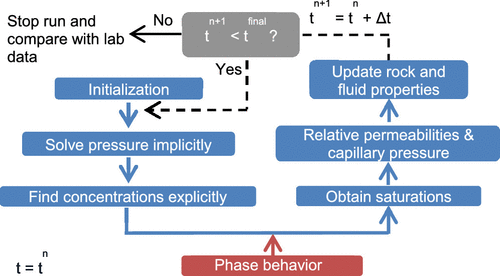当前位置:
X-MOL 学术
›
Ind. Eng. Chem. Res.
›
论文详情
Our official English website, www.x-mol.net, welcomes your
feedback! (Note: you will need to create a separate account there.)
Mechanistic Modeling of Water-Alternating-Gas Injection and Foam-Assisted Chemical Flooding for Enhanced Oil Recovery
Industrial & Engineering Chemistry Research ( IF 3.8 ) Pub Date : 2020-02-14 , DOI: 10.1021/acs.iecr.9b06356 Martijn T. G. Janssen 1 , Fabian A. Torres Mendez 1 , Pacelli L. J. Zitha 1
Industrial & Engineering Chemistry Research ( IF 3.8 ) Pub Date : 2020-02-14 , DOI: 10.1021/acs.iecr.9b06356 Martijn T. G. Janssen 1 , Fabian A. Torres Mendez 1 , Pacelli L. J. Zitha 1
Affiliation

|
History-matching of core-flood experimental data through numerical modeling is a powerful tool to get insight into the relevant physical parameters and mechanisms that control fluid flow in enhanced oil recovery processes. We conducted a mechanistic numerical simulation study aiming at modeling previously performed water-alternating-gas and foam-assisted chemical flooding core-flood experiments. For each experiment, a one-dimensional model was built. The obtained computed tomography scan data was used to assign varying porosity, and permeability, values to each grid block. The main goal of this study was to history-match measured phase saturation profiles along the core length, pressure drops, produced phase cuts, and the oil recovery history for each of the experiments conducted. The results show that, to obtain a good match for the water-alternating-gas experiment, gas relative permeability needs to be reduced as a function of injection time due to gas trapping. The surfactant phase behavior, for the aid of foam-assisted chemical flooding, was successfully simulated and its robustness was verified by effectively applying the same phase behavior model to the two different salinity conditions studied. It resulted in the oil mobilization, through the injection of a surfactant slug, being properly modeled. The mechanistic simulation of foam using the steady-state foam model built in UTCHEM proved inadequate for the mechanistic modeling of a foam drive in the presence of oil. An alternative heuristic approach was adopted to overcome this limitation.
中文翻译:

注水交替注气和泡沫辅助化学驱提高采收率的机理模型
通过数值建模对岩心驱替实验数据进行历史匹配是一种功能强大的工具,可以深入了解相关的物理参数和机制,以控制强化采油过程中的流体流动。我们进行了一项机械数值模拟研究,旨在对先前进行的水交替气和泡沫辅助化学驱油心驱实验进行建模。对于每个实验,建立一个一维模型。获得的计算机断层扫描数据用于为每个网格块分配不同的孔隙率和渗透率值。这项研究的主要目的是使所进行的每个实验沿堆芯长度,压降,产生的切相和油采收历史沿历史测得的相饱和度曲线匹配。结果表明,为了获得与水交替气体实验的良好匹配,由于气体捕集,需要根据注入时间来降低气体相对渗透率。成功地模拟了表面活性剂的相行为,以辅助泡沫辅助化学驱,并通过将相同的相行为模型有效地应用于研究的两种不同盐度条件,验证了其稳健性。通过注入表面活性剂段塞,可以正确模拟油的流动性。使用UTCHEM中建立的稳态泡沫模型进行的泡沫力学模拟证明不足以在有油的情况下对泡沫驱动器进行力学建模。采用了另一种启发式方法来克服此限制。由于气体的捕集,需要根据注入时间来降低气体的相对渗透率。成功地模拟了表面活性剂的相行为,以辅助泡沫辅助化学驱,并通过将相同的相行为模型有效地应用于研究的两种不同盐度条件,验证了其稳健性。通过注入表面活性剂段塞,可以正确模拟油的流动性。使用UTCHEM中建立的稳态泡沫模型进行的泡沫力学模拟被证明不足以在有油的情况下对泡沫驱动器进行力学建模。采用了另一种启发式方法来克服此限制。由于气体的捕集,需要根据注入时间来降低气体的相对渗透率。成功地模拟了表面活性剂的相行为,以辅助泡沫辅助化学驱,并通过将相同的相行为模型有效地应用于研究的两种不同盐度条件,验证了其稳健性。通过注入表面活性剂段塞,可以正确模拟油的流动性。使用UTCHEM中建立的稳态泡沫模型进行的泡沫力学模拟证明不足以在有油的情况下对泡沫驱动器进行力学建模。采用了另一种启发式方法来克服此限制。通过成功地对相同的相行为模型应用到所研究的两个不同盐度条件,成功地进行了模拟,并验证了其鲁棒性。通过注入表面活性剂段塞,可以正确模拟油的流动性。使用UTCHEM中建立的稳态泡沫模型进行的泡沫力学模拟证明不足以在有油的情况下对泡沫驱动器进行力学建模。采用了另一种启发式方法来克服此限制。通过对两个不同的盐度条件有效地使用相同的相行为模型,成功地模拟并验证了其鲁棒性。通过注入表面活性剂段塞,可以正确模拟油的流动性。使用UTCHEM中建立的稳态泡沫模型进行的泡沫力学模拟被证明不足以在有油的情况下对泡沫驱动器进行力学建模。采用了另一种启发式方法来克服此限制。使用UTCHEM中建立的稳态泡沫模型进行的泡沫力学模拟被证明不足以在有油的情况下对泡沫驱动器进行力学建模。采用了另一种启发式方法来克服此限制。使用UTCHEM中建立的稳态泡沫模型进行的泡沫力学模拟被证明不足以在有油的情况下对泡沫驱动器进行力学建模。采用了另一种启发式方法来克服此限制。
更新日期:2020-02-17
中文翻译:

注水交替注气和泡沫辅助化学驱提高采收率的机理模型
通过数值建模对岩心驱替实验数据进行历史匹配是一种功能强大的工具,可以深入了解相关的物理参数和机制,以控制强化采油过程中的流体流动。我们进行了一项机械数值模拟研究,旨在对先前进行的水交替气和泡沫辅助化学驱油心驱实验进行建模。对于每个实验,建立一个一维模型。获得的计算机断层扫描数据用于为每个网格块分配不同的孔隙率和渗透率值。这项研究的主要目的是使所进行的每个实验沿堆芯长度,压降,产生的切相和油采收历史沿历史测得的相饱和度曲线匹配。结果表明,为了获得与水交替气体实验的良好匹配,由于气体捕集,需要根据注入时间来降低气体相对渗透率。成功地模拟了表面活性剂的相行为,以辅助泡沫辅助化学驱,并通过将相同的相行为模型有效地应用于研究的两种不同盐度条件,验证了其稳健性。通过注入表面活性剂段塞,可以正确模拟油的流动性。使用UTCHEM中建立的稳态泡沫模型进行的泡沫力学模拟证明不足以在有油的情况下对泡沫驱动器进行力学建模。采用了另一种启发式方法来克服此限制。由于气体的捕集,需要根据注入时间来降低气体的相对渗透率。成功地模拟了表面活性剂的相行为,以辅助泡沫辅助化学驱,并通过将相同的相行为模型有效地应用于研究的两种不同盐度条件,验证了其稳健性。通过注入表面活性剂段塞,可以正确模拟油的流动性。使用UTCHEM中建立的稳态泡沫模型进行的泡沫力学模拟被证明不足以在有油的情况下对泡沫驱动器进行力学建模。采用了另一种启发式方法来克服此限制。由于气体的捕集,需要根据注入时间来降低气体的相对渗透率。成功地模拟了表面活性剂的相行为,以辅助泡沫辅助化学驱,并通过将相同的相行为模型有效地应用于研究的两种不同盐度条件,验证了其稳健性。通过注入表面活性剂段塞,可以正确模拟油的流动性。使用UTCHEM中建立的稳态泡沫模型进行的泡沫力学模拟证明不足以在有油的情况下对泡沫驱动器进行力学建模。采用了另一种启发式方法来克服此限制。通过成功地对相同的相行为模型应用到所研究的两个不同盐度条件,成功地进行了模拟,并验证了其鲁棒性。通过注入表面活性剂段塞,可以正确模拟油的流动性。使用UTCHEM中建立的稳态泡沫模型进行的泡沫力学模拟证明不足以在有油的情况下对泡沫驱动器进行力学建模。采用了另一种启发式方法来克服此限制。通过对两个不同的盐度条件有效地使用相同的相行为模型,成功地模拟并验证了其鲁棒性。通过注入表面活性剂段塞,可以正确模拟油的流动性。使用UTCHEM中建立的稳态泡沫模型进行的泡沫力学模拟被证明不足以在有油的情况下对泡沫驱动器进行力学建模。采用了另一种启发式方法来克服此限制。使用UTCHEM中建立的稳态泡沫模型进行的泡沫力学模拟被证明不足以在有油的情况下对泡沫驱动器进行力学建模。采用了另一种启发式方法来克服此限制。使用UTCHEM中建立的稳态泡沫模型进行的泡沫力学模拟被证明不足以在有油的情况下对泡沫驱动器进行力学建模。采用了另一种启发式方法来克服此限制。











































 京公网安备 11010802027423号
京公网安备 11010802027423号